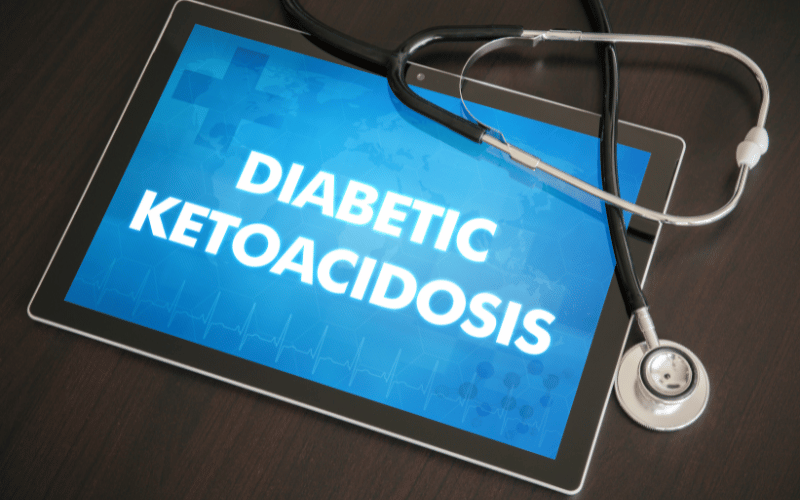Introduction: Navigating the Complexities of Diabetic Ketoacidosis (DKA)
Diabetic Ketoacidosis (DKA) is a severe condition predominantly seen in individuals with type 1 diabetes, though it can also affect those with type 2 diabetes under specific circumstances. The complexity of DKA stems from its ability to rapidly escalate, posing significant health risks. It’s characterized by a combination of high blood sugar (hyperglycemia), ketosis (where the body breaks down fat for energy), and acidosis (increased acidity in the blood).

The condition often develops in response to an underlying trigger, such as an infection, missed insulin doses, or significant stress. These triggers lead to an increased production of counter-regulatory hormones like glucagon, cortisol, and adrenaline, which oppose insulin’s action. Without sufficient insulin, the body cannot utilize glucose for energy effectively, prompting the breakdown of fat as an alternative source. This fat metabolism produces ketones, which can accumulate in the blood, creating an acidic environment.
Early detection and management of DKA are critical. It begins with recognizing its symptoms and understanding their implications. In this comprehensive exploration, we’ll delve into the ten cardinal symptoms of DKA, each shedding light on the intricate workings of this medical emergency. By equipping yourself with this knowledge, you can better navigate the signs and seek timely medical intervention, potentially saving lives.
The psychological impact of DKA should not be underestimated. Living with the constant vigilance required for diabetes management can be overwhelming, and the added fear of developing DKA adds to this burden. Patients and caregivers must be attuned to the physical symptoms of DKA and also mindful of the emotional and psychological toll it can take. Understanding DKA is not just about recognizing its physical manifestations; it’s also about acknowledging and addressing the mental and emotional aspects of managing a chronic condition like diabetes.
Symptom 1: Excessive Thirst – The Unrelenting Signal of Dehydration

Excessive thirst, a condition medically termed as polydipsia, is one of the most noticeable symptoms of Diabetic Ketoacidosis (DKA). This relentless thirst arises from the body’s response to elevated blood sugar levels. When glucose levels in the blood soar, the body attempts to dilute this concentration by drawing water from cells, leading to dehydration. This physiological response triggers the brain to signal thirst, urging an increase in fluid intake. The body’s desperate attempt to rehydrate itself becomes a continuous cycle, as the underlying high blood sugar levels persist.
In DKA, the kidneys play a pivotal role in the symptom of excessive thirst. They are tasked with filtering and reabsorbing glucose from the blood. However, when blood glucose levels exceed the kidneys’ capacity to reabsorb, glucose is excreted in the urine, drawing water along with it. This process, known as osmotic diuresis, leads to frequent urination and further exacerbates dehydration. The loss of fluids prompts the body to crave more water, resulting in excessive thirst. This symptom is both a warning and a consequence of the body’s struggle to manage high glucose levels.
The symptom of excessive thirst in DKA is not just a response to dehydration but also part of a vicious cycle involving high blood sugar. As the body becomes dehydrated, the concentration of glucose in the blood can rise even further, perpetuating the problem. This cycle of dehydration and high blood sugar creates a challenging situation where merely drinking water is insufficient to rectify the imbalance. Managing this symptom requires addressing the underlying high blood sugar levels, often necessitating medical intervention.
For individuals with diabetes, especially those prone to DKA, recognizing excessive thirst as a red flag is crucial. This symptom is often one of the first signs of escalating blood sugar levels and impending DKA. Being attuned to changes in thirst and hydration status can prompt early testing of blood sugar levels and ketones, potentially averting a full-blown DKA episode. It is a symptom that should never be ignored, as it signifies a deeper imbalance in the body’s metabolic state.
The significance of excessive thirst in the context of DKA extends beyond mere discomfort. It is a critical indicator that demands prompt action. Ignoring this symptom can lead to a rapid deterioration of the individual’s condition, propelling them closer to severe dehydration and metabolic chaos. Awareness and timely intervention, including consultation with healthcare providers, are essential in managing this symptom effectively and preventing the progression of DKA. (1)